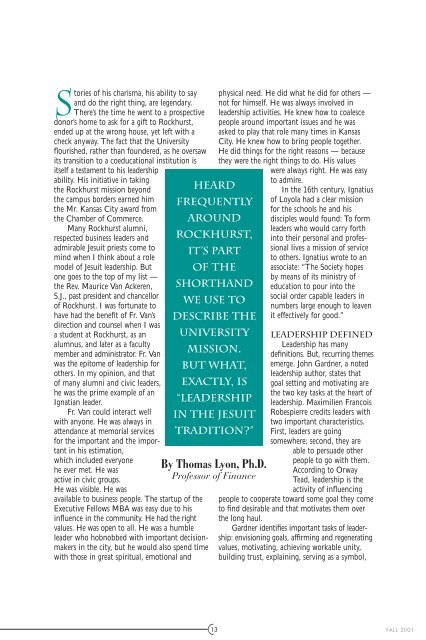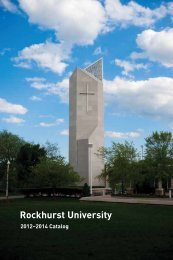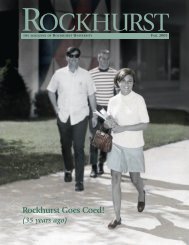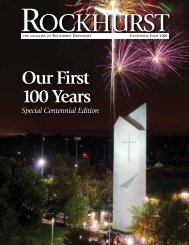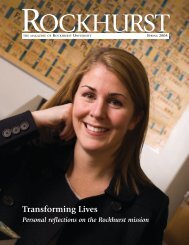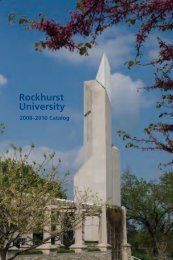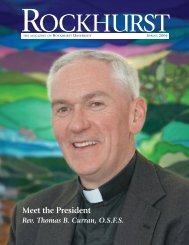in the Jesuit Tradition - Rockhurst University
in the Jesuit Tradition - Rockhurst University
in the Jesuit Tradition - Rockhurst University
Create successful ePaper yourself
Turn your PDF publications into a flip-book with our unique Google optimized e-Paper software.
Stories of his charisma, his ability to sayand do <strong>the</strong> right th<strong>in</strong>g, are legendary.There’s <strong>the</strong> time he went to a prospectivedonor’s home to ask for a gift to <strong>Rockhurst</strong>,ended up at <strong>the</strong> wrong house, yet left with acheck anyway. The fact that <strong>the</strong> <strong>University</strong>flourished, ra<strong>the</strong>r than foundered, as he oversawits transition to a coeducational <strong>in</strong>stitution isitself a testament to his leadershipability. His <strong>in</strong>itiative <strong>in</strong> tak<strong>in</strong>g<strong>the</strong> <strong>Rockhurst</strong> mission beyond<strong>the</strong> campus borders earned him<strong>the</strong> Mr. Kansas City award from<strong>the</strong> Chamber of Commerce.Many <strong>Rockhurst</strong> alumni,respected bus<strong>in</strong>ess leaders andadmirable <strong>Jesuit</strong> priests come tom<strong>in</strong>d when I th<strong>in</strong>k about a rolemodel of <strong>Jesuit</strong> leadership. Butone goes to <strong>the</strong> top of my list —<strong>the</strong> Rev. Maurice Van Ackeren,S.J., past president and chancellorof <strong>Rockhurst</strong>. I was fortunate tohave had <strong>the</strong> benefit of Fr. Van’sdirection and counsel when I wasa student at <strong>Rockhurst</strong>, as analumnus, and later as a facultymember and adm<strong>in</strong>istrator. Fr. Vanwas <strong>the</strong> epitome of leadership foro<strong>the</strong>rs. In my op<strong>in</strong>ion, and thatof many alumni and civic leaders,he was <strong>the</strong> prime example of anIgnatian leader.Fr. Van could <strong>in</strong>teract wellwith anyone. He was always <strong>in</strong>attendance at memorial servicesfor <strong>the</strong> important and <strong>the</strong> important<strong>in</strong> his estimation,which <strong>in</strong>cluded everyonehe ever met. He wasactive <strong>in</strong> civic groups.He was visible. He wasavailable to bus<strong>in</strong>ess people. The startup of <strong>the</strong>Executive Fellows MBA was easy due to his<strong>in</strong>fluence <strong>in</strong> <strong>the</strong> community. He had <strong>the</strong> rightvalues. He was open to all. He was a humbleleader who hobnobbed with important decisionmakers<strong>in</strong> <strong>the</strong> city, but he would also spend timewith those <strong>in</strong> great spiritual, emotional andHeardfrequentlyaround<strong>Rockhurst</strong>,it’s partof <strong>the</strong>shorthandwe use todescribe <strong>the</strong>universitymission.But what,exactly, is“Leadership<strong>in</strong> <strong>the</strong> <strong>Jesuit</strong><strong>Tradition</strong>?”By Thomas Lyon, Ph.D.Professor of F<strong>in</strong>ancephysical need. He did what he did for o<strong>the</strong>rs —not for himself. He was always <strong>in</strong>volved <strong>in</strong>leadership activities. He knew how to coalescepeople around important issues and he wasasked to play that role many times <strong>in</strong> KansasCity. He knew how to br<strong>in</strong>g people toge<strong>the</strong>r.He did th<strong>in</strong>gs for <strong>the</strong> right reasons — because<strong>the</strong>y were <strong>the</strong> right th<strong>in</strong>gs to do. His valueswere always right. He was easyto admire.In <strong>the</strong> 16th century, Ignatiusof Loyola had a clear missionfor <strong>the</strong> schools he and hisdisciples would found: To formleaders who would carry forth<strong>in</strong>to <strong>the</strong>ir personal and professionallives a mission of serviceto o<strong>the</strong>rs. Ignatius wrote to anassociate: “The Society hopesby means of its m<strong>in</strong>istry ofeducation to pour <strong>in</strong>to <strong>the</strong>social order capable leaders <strong>in</strong>numbers large enough to leavenit effectively for good.”Leadership Def<strong>in</strong>edLeadership has manydef<strong>in</strong>itions. But, recurr<strong>in</strong>g <strong>the</strong>mesemerge. John Gardner, a notedleadership author, states thatgoal sett<strong>in</strong>g and motivat<strong>in</strong>g are<strong>the</strong> two key tasks at <strong>the</strong> heart ofleadership. Maximilien FrancoisRobespierre credits leaders withtwo important characteristics.First, leaders are go<strong>in</strong>gsomewhere; second, <strong>the</strong>y areable to persuade o<strong>the</strong>rpeople to go with <strong>the</strong>m.Accord<strong>in</strong>g to OrwayTead, leadership is <strong>the</strong>activity of <strong>in</strong>fluenc<strong>in</strong>gpeople to cooperate toward some goal <strong>the</strong>y cometo f<strong>in</strong>d desirable and that motivates <strong>the</strong>m over<strong>the</strong> long haul.Gardner identifies important tasks of leadership:envision<strong>in</strong>g goals, affirm<strong>in</strong>g and regenerat<strong>in</strong>gvalues, motivat<strong>in</strong>g, achiev<strong>in</strong>g workable unity,build<strong>in</strong>g trust, expla<strong>in</strong><strong>in</strong>g, serv<strong>in</strong>g as a symbol,13 FALL 2001


